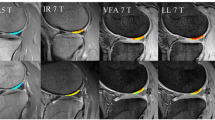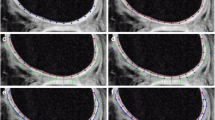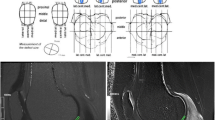Abstract
Objectives
To assess the reproducibility of 3D delayed gadolinium-enhanced MRI of cartilage (dGEMRIC) at 3 T in early stage knee osteoarthritis (OA) patients.
Methods
In 20 patients, 3D dGEMRIC at 3 T was acquired twice within 7 days. To correct for patient motion during acquisition, all images were rigidly registered in 3D. Eight anatomical cartilage ROIs were analysed on both images of each patient. Capability of dGEMRIC to yield T1 maps that reproducibly distinguish spatial differences in cartilage quality was assessed in two ROIs within a single slice in each patient. Reproducibility was assessed using ICCs and Bland-Altman plots.
Results
ICCs ranged from 0.87 to 0.95, indicating good reproducibility. T1 maps revealed reproducible spatial differences in cartilage quality (ICC 0.79). Based on the Bland-Altman plots, we defined a threshold of 95 ms to determine if a change in dGEMRIC outcome in longitudinal research was statistically significant.
Conclusions
3D knee dGEMRIC at 3 T combined with 3D image registration is a highly reproducible measure of cartilage quality in early stage OA. Therefore, dGEMRIC may be a valuable tool in the non-invasive evaluation of cartilage quality changes in longitudinal research in patients with early stage OA and focal cartilage defects.
Key Points
• Delayed gadolinium-enhanced magnetic resonance imaging of cartilage (dGEMRIC) can assess osteoarthritis
• dGEMRIC yields highly reproducible T1 values in early stage osteoarthritic patients
• A threshold was established to determine significant changes in dGEMRIC outcomes
• dGEMRIC can be used to evaluate cartilage quality in longitudinal research






Similar content being viewed by others
Abbreviations
- ACLT:
-
Anterior cruciate ligament tear
- dGEMRIC:
-
Delayed gadolinium-enhanced magnetic resonance imaging of cartilage
- ICC:
-
Intraclass correlation coefficient
- OA:
-
Osteoarthritis
- pFC:
-
Posterior non-weight-bearing cartilage of the femoral condyle
- ROIs:
-
Regions of interest
- sGAG:
-
Sulphated glycosaminoglycan
- TI:
-
Inversion time
- wbFCa:
-
Anterior weight-bearing cartilage of the femoral condyle
- wbFCp:
-
Posterior weight-bearing cartilage of the femoral condyle
- wbTP:
-
Weight-bearing cartilage of the tibial plateau
References
Buckwalter JA, Saltzman C, Brown T (2004) The impact of osteoarthritis: implications for research. Clin Orthop Relat Res 427(Suppl):S6–S15
Hermans J, Koopmanschap MA, Bierma-Zeinstra SM et al (2012) Productivity costs and medical costs among working patients with knee osteoarthritis. Arthritis Care Res (Hoboken) 64:853–861
Woolf AD, Pfleger B (2003) Burden of major musculoskeletal conditions. Bull World Health Organ 81:646–656
Kellgren JH, Lawrence JS (1957) Radiological assessment of osteo-arthrosis. Ann Rheum Dis 16:494–502
Hunter DJ (2011) Pharmacologic therapy for osteoarthritis–the era of disease modification. Nat Rev Rheumatol 7:13–22
Guermazi A, Roemer FW, Burstein D, Hayashi D (2011) Why radiography should no longer be considered a surrogate outcome measure for longitudinal assessment of cartilage in knee osteoarthritis. Arthritis Res Ther 13:247
Bashir A, Gray ML, Hartke J, Burstein D (1999) Nondestructive imaging of human cartilage glycosaminoglycan concentration by MRI. Magn Reson Med 41:857–865
Tiderius CJ, Olsson LE, Leander P, Ekberg O, Dahlberg L (2003) Delayed gadolinium-enhanced MRI of cartilage (dGEMRIC) in early knee osteoarthritis. Magn Reson Med 49:488–492
Tiderius CJ, Olsson LE, Nyquist F, Dahlberg L (2005) Cartilage glycosaminoglycan loss in the acute phase after an anterior cruciate ligament injury: delayed gadolinium-enhanced magnetic resonance imaging of cartilage and synovial fluid analysis. Arthritis Rheum 52:120–127
Trattnig S, Marlovits S, Gebetsroither S et al (2007) Three-dimensional delayed gadolinium-enhanced MRI of cartilage (dGEMRIC) for in vivo evaluation of reparative cartilage after matrix-associated autologous chondrocyte transplantation at 3.0 T: Preliminary results. J Magn Reson Imaging 26:974–982
Vasiliadis HS, Danielson B, Ljungberg M, McKeon B, Lindahl A, Peterson L (2010) Autologous chondrocyte implantation in cartilage lesions of the knee: long-term evaluation with magnetic resonance imaging and delayed gadolinium-enhanced magnetic resonance imaging technique. Am J Sports Med 38:943–949
Gillis A, Bashir A, McKeon B, Scheller A, Gray ML, Burstein D (2001) Magnetic resonance imaging of relative glycosaminoglycan distribution in patients with autologous chondrocyte transplants. Invest Radiol 36:743–748
Trattnig S, Burstein D, Szomolanyi P, Pinker K, Welsch GH, Mamisch TC (2009) T1(Gd) gives comparable information as Delta T1 relaxation rate in dGEMRIC evaluation of cartilage repair tissue. Invest Radiol 44:598–602
Burstein D, Velyvis J, Scott KT et al (2001) Protocol issues for delayed Gd(DTPA)(2-)-enhanced MRI (dGEMRIC) for clinical evaluation of articular cartilage. Magn Reson Med 45:36–41
Multanen J, Rauvala E, Lammentausta E et al (2009) Reproducibility of imaging human knee cartilage by delayed gadolinium-enhanced MRI of cartilage (dGEMRIC) at 1.5 Tesla. Osteoarthr Cartil 17:559–564
Siversson C, Tiderius CJ, Neuman P, Dahlberg L, Svensson J (2010) Repeatability of T1-quantification in dGEMRIC for three different acquisition techniques: two-dimensional inversion recovery, three-dimensional look locker, and three-dimensional variable flip angle. J Magn Reson Imaging 31:1203–1209
Felson DT, Lawrence RC, Dieppe PA et al (2000) Osteoarthritis: new insights. Part 1: the disease and its risk factors. Ann Intern Med 133:635–646
Jensen MP, Miller L, Fisher LD (1998) Assessment of pain during medical procedures: a comparison of three scales. Clin J Pain 14:343–349
Ferraz MB, Quaresma MR, Aquino LR, Atra E, Tugwell P, Goldsmith CH (1990) Reliability of pain scales in the assessment of literate and illiterate patients with rheumatoid arthritis. J Rheumatol 17:1022–1024
Mayerhoefer ME, Welsch GH, Mamisch TC et al (2010) The in vivo effects of unloading and compression on T1-Gd (dGEMRIC) relaxation times in healthy articular knee cartilage at 3.0 Tesla. Eur Radiol 20:443–449
McKenzie CA, Williams A, Prasad PV, Burstein D (2006) Three-dimensional delayed gadolinium-enhanced MRI of cartilage (dGEMRIC) at 1.5T and 3.0T. J Magn Reson Imaging 24:928–933
Eckstein F, Ateshian G, Burgkart R et al (2006) Proposal for a nomenclature for magnetic resonance imaging based measures of articular cartilage in osteoarthritis. Osteoarthr Cartil 14:974–983
Tiderius CJ, Tjornstrand J, Akeson P, Sodersten K, Dahlberg L, Leander P (2004) Delayed gadolinium-enhanced MRI of cartilage (dGEMRIC): intra- and interobserver variability in standardized drawing of regions of interest. Acta Radiol 45:628–634
Tiderius CJ, Olsson LE, de Verdier H, Leander P, Ekberg O, Dahlberg L (2001) Gd-DTPA2)-enhanced MRI of femoral knee cartilage: a dose–response study in healthy volunteers. Magn Reson Med 46:1067–1071
Miese F, Kropil P, Ostendorf B et al (2011) Motion correction improves image quality of dGEMRIC in finger joints. Eur J Radiol 80:e427–e431
Studler U, White LM, Andreisek G, Luu S, Cheng HL, Sussman MS (2010) Impact of motion on T1 mapping acquired with inversion recovery fast spin echo and rapid spoiled gradient recalled-echo pulse sequences for delayed gadolinium-enhanced MRI of cartilage (dGEMRIC) in volunteers. J Magn Reson Imaging 32:394–398
Bron EE, van Tiel J, Smit H et al (2012) Image registration improves human knee cartilage T1 mapping with delayed Gadolinium Enhanced MRI of Cartilage (dGEMRIC). Eur Radiol. doi:10.1007/s00330-012-2590-3
Klein S, Staring M, Murphy K, Viergever MA, Pluim JP (2010) Elastix: a toolbox for intensity-based medical image registration. IEEE Trans Med Imaging 29:196–205
Cavassila S, Deval S, Huegen C, van Ormondt D, Graveron-Demilly D (2001) Cramer-Rao bounds: an evaluation tool for quantitation. NMR Biomed 14:278–283
Sijbers J, Den Dekker AJ, Raman E, Van Dyck D (1999) Parameter estimation from magnitude MR images. Int J Imag Syst Tech 10:109–114
Rao CR (1946) Minimum variance and the estimation of several parameters. Cambridge Univ Press 43:280–283
Atkinson G, Nevill AM (1998) Statistical methods for assessing measurement error (reliability) in variables relevant to sports medicine. Sports Med 26:217–238
Bland JM, Altman DG (1986) Statistical methods for assessing agreement between two methods of clinical measurement. Lancet 1:307–310
Buckwalter JA, Mankin HJ (1998) Articular cartilage: degeneration and osteoarthritis, repair, regeneration, and transplantation. Instr Course Lect 47:487–504
Bedi A, Feeley BT, Williams RJ 3rd (2010) Management of articular cartilage defects of the knee. J Bone Joint Surg Am 92:994–1009
Bos PK, van Melle ML, van Osch GJ (2010) Articular cartilage repair and the evolving role of regenerative medicine. Open Access Surgery 3:109–122
Hawezi ZK, Lammentausta E, Svensson J, Dahlberg LE, Tiderius CJ (2011) In vivo transport of Gd-DTPA(2-) in human knee cartilage assessed by depth-wise dGEMRIC analysis. J Magn Reson Imaging 34:1352–1358
Acknowledgments
Prof. G.P. Krestin is a consultant to GE and has a collaboration contract with them
Author information
Authors and Affiliations
Corresponding author
Rights and permissions
About this article
Cite this article
van Tiel, J., Bron, E.E., Tiderius, C.J. et al. Reproducibility of 3D delayed gadolinium enhanced MRI of cartilage (dGEMRIC) of the knee at 3.0 T in patients with early stage osteoarthritis. Eur Radiol 23, 496–504 (2013). https://doi.org/10.1007/s00330-012-2616-x
Received:
Revised:
Accepted:
Published:
Issue Date:
DOI: https://doi.org/10.1007/s00330-012-2616-x




